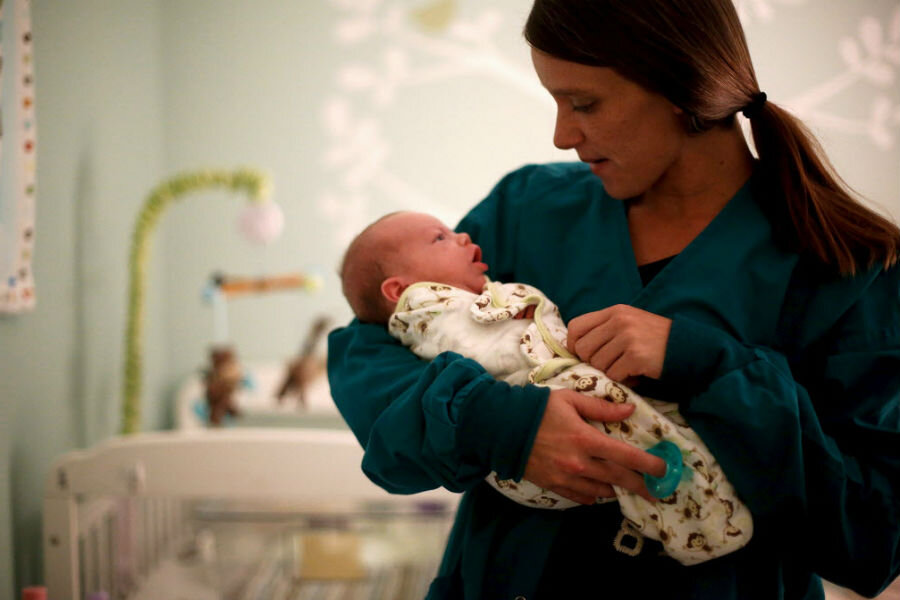Why are rural areas seeing a rise in drug-dependent newborns?
Loading...
Roughly 1 out of every 130 babies in rural America are born dependent on drugs, according to a study published Monday.
The report, published in JAMA Pediatrics, shows a dramatic increase in neonatal abstinence syndrome – when a newborn baby is dependent on drugs and goes through withdrawal after birth – in rural areas between 2004 and 2013. In just a decade, the number of rural newborns suffering from chemical dependency skyrocketed from 1.2 per every 1,000 hospital births to 7.5 per 1,000.
While previous research has suggested an increase in neonatal abstinence syndrome in certain areas, the findings published Monday are the first to show just how widespread of a problem newborn drug dependency is across rural America, fueled by an increase in opioid use among women of all social classes and insufficient resources in far-flung areas to treat drug addiction.
"Prior to our study, we had limited data from a few states like West Virginia and Tennessee that showed rising rates of neonatal abstinence syndrome in some rural counties," lead study author Nicole Villapiano told Reuters. "What we didn't know was how the opioid crisis has affected rural moms and their infants across the country."
As the number of babies born with neonatal abstinence syndrome has seen a steady increase over the past decade, communities and public health experts across the country have begun to grapple with how to quell the scourge, as Stacy Teicher Khadaroo reported for The Christian Science Monitor in March:
Around the United States, communities have been struggling to craft policies to deal with what has become one of the most pressing issues facing society – the misuse of painkillers, which in turn leads some people to start taking heroin. Their efforts range from advocating tougher law enforcement to educating doctors to putting limits on the amount of painkillers that can be prescribed to patients. Exacerbating the problem is the discouraging reality that only about 20 percent of those who struggled with illicit drug use in 2014 received treatment, a government survey found.
While the effect of the crisis on adults is daunting enough – heroin-related overdoses have nearly quadrupled in the past decade – it becomes particularly heart-rending when it reaches into the nation’s hospital nurseries.
Especially notable in the most recent research findings is the growing gap between rural and urban areas, researchers say. In the 1970s, drug withdrawal symptoms affected mostly babies of heroin-addicted mothers in large cities, Veeral Tolia, a neonatologist with Baylor University Medical Center in Dallas who was not involved in the study, told The New York Times.
By 2004, neonatal abstinence syndrome had spread to rural areas, though it was still slightly more common in cities: 1.4 out of every 1,000 babies in urban hospitals were affected at the time, compared with 1.2 out of every 1,000 rural babies. For newborns in urban areas, that number has since risen to 4.8 out of every 1,000.
"The problem is accelerating in rural areas to a greater degree than in urban areas," Dr. Tolia said. "What this study shows is this has totally flipped."
While the researchers note that some of the increase may be the result of growing awareness of the condition, experts have attributed the numbers in part to an uptick in the use of painkillers among women in all geographic areas and economic brackets.
"The increase that you see in the JAMA data relates to a more widespread use of pain medications across all social classes," Terrie Inder, chair of pediatric newborn medicine at Brigham and Women’s Hospital in Boston, told CBS. "Now, we are equally likely to see a mother from a middle class or upper middle class background who was unaware that taking these medicines could lead to that type of consequence for her baby."
In rural areas, experts say, there tend to be fewer resources for expectant mothers to deal with addiction, prompting the authors of the new study to call for more funding to deal with the opioid crisis in these areas.
Some lawmakers have already begun to address the issue. In May, the US House of Representatives unanimously passed legislation to raise the standard of safety planning for children born with a dependency on opiates. Two months later, President Obama signed into law the Comprehensive Addiction and Recovery Act, which stipulated that federal officials should give priority to funding programs in rural areas to improve treatment for pregnant women.
"It’s the first time to my knowledge that that population has been recognized as being underserved, and was targeted specifically, and I think it’s real progress," Mark Dunn, the director of public policy for the National Association of Addiction Treatment Providers, told the New York Times.
The next step, advocates say, is removing the cultural stigma of opioid addiction that may be preventing some women from seeking treatment.
"In small towns where everyone knows you, there’s a fear of going to a local doctor to seek care. There’s the fear people will talk, will judge you," Laura Jones, director at Milan Puskar Health Right, a free primary care clinic in West Virginia, told ThinkProgress. "But what people don’t know is that half of the town is addicted."








